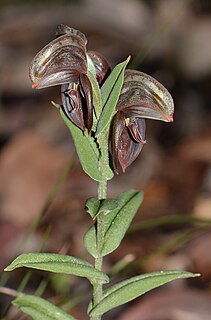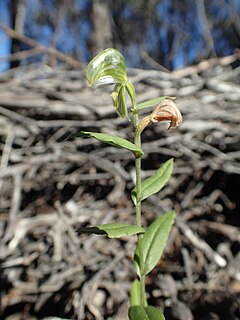
Pterostylis barbata, commonly known as the western bearded greenhood or bird orchid is a species of orchid endemic to the south-west of Western Australia. Flowering plants have a rosette of leaves at the base of the plant and a single translucent white flower with dark green veins on a flowering stem with up to 20 stem leaves. It is one of a number of bearded orchids, some of which have yet to be formally described, all of which have a distinctive feather-like labellum.
Pterostylis ciliata, commonly known as the hairy rufous greenhood, tall rusthood or hairy rustyhood is a plant in the orchid family Orchidaceae and is endemic to the south-west of Western Australia. It has a relatively large rosette of leaves at its base and up to eight or more green and brown flowers which lean forward and have a small, fleshy, insect-like labellum covered with hairs.

Pterostylis concava, commonly known as the pouched greenhood or cupped banded greenhood, is a plant in the orchid family Orchidaceae and is endemic to the south-west of Western Australia. The plants either have a rosette of leaves in the years when not flowering or stem leaves on a flowering spike. When flowering, it has up to ten or more flowers which are dark reddish-brown, sometimes green and white with deeply cupped lateral sepals. It is an uncommon orchid, mostly found between Bindoon and Mount Barker.
Pterostylis gibbosa, commonly known as the Illawarra rustyhood, or Illawarra greenhood, is a plant in the orchid family Orchidaceae and is endemic to New South Wales. It has a rosette of leaves at its base and up to nine bright green flowers with translucent "windows", relatively wide lateral sepals with short-pointed tips and a dark, fleshy, insect-like labellum.
Pterostylis insectifera, commonly known as the insect-lipped rufous greenhood, or leaden rustyhood is a plant in the orchid family Orchidaceae and is endemic to the south-west of Western Australia. Both flowering and non-flowering plants have a relatively large rosette of leaves. Flowering plants have a similar rosette and up to eight or more flowers which have long, stiffly-held lateral sepals and a protruding, insect-like labellum.
Pterostylis lepida, commonly known as the Halbury greenhood is a plant in the orchid family Orchidaceae and is endemic to South Australia. Both flowering and non-flowering plants have a rosette of leaves. Flowering plants have up to ten green flowers with brown and translucent striations and a small, insect-like labellum. It is only known from two small populations.

Pterostylis leptochila, commonly known as the Ravensthorpe rufous greenhood or narrow-lipped rustyhood is a plant in the orchid family Orchidaceae and is endemic to the south-west of Western Australia. Both flowering and non-flowering plants have a relatively large rosette of leaves. Flowering plants also have up to five large translucent white flowers with olive green and brown lines and markings and a narrow, insect-like labellum.
Pterostylis macrocalymma, commonly known as the large-hooded rufous greenhood or Murchison rustyhood is a plant in the orchid family Orchidaceae and is endemic to the south-west of Western Australia. Both flowering and non-flowering plants have a relatively large rosette of leaves. Flowering plants also have up to ten or more white flowers with bold green or pale brown lines and a broad spoon-shaped, insect-like labellum.
Pterostylis macrosceles, commonly known as the slender rufous greenhood is a plant in the orchid family Orchidaceae and is endemic to the south-west of Western Australia. Both flowering and non-flowering plants have a relatively large rosette of leaves. Flowering plants also have between four and eight white flowers with green brown lines and small, insect-like labellum. It is distinguished from other Western Australian greenhoods by the unusually long thread-like tips on its sepals.

Pterostylis microphylla, commonly known as the small rosette snail orchid, is a species of orchid endemic to the south-west of Western Australia. As with similar greenhoods, the flowering plants differ from those which are not flowering. The non-flowering plants have a rosette of leaves flat on the ground but the flowering plants have a single flower with leaves on the flowering spike. In this species, the flower is white and green with narrow, erect lateral sepals and a small labellum.

Pterostylis mirabilis, commonly known as the nodding rufous-hood, is a plant in the orchid family Orchidaceae and is endemic to South Australia. It has a rosette of leaves at its base and up to ten greenish-white flowers with a narrow hood, down-turned lateral sepals and a thin-textured, insect-like labellum.
Pterostylis perculta, commonly known as the ruddy hood is a plant in the orchid family Orchidaceae and is endemic to the south-west of Western Australia. Both flowering and non-flowering plants have a relatively large rosette of leaves and flowering plants have up to five reddish-brown and white flowers with relatively short tips on the sepals.
Pterostylis picta, commonly known as the painted rufous greenhood or painted rustyhood is a plant in the orchid family Orchidaceae and is endemic to the south-west of Western Australia. Both flowering and non-flowering plants have a relatively large rosette of leaves. Flowering plants also have up to seven large translucent white flowers with green and brown stripes and markings and a fleshy, insect-like labellum.
Pterostylis psammophila, commonly known as the two-bristle greenhood, is a plant in the orchid family Orchidaceae and is endemic to South Australia. Both flowering and non-flowering plants have a rosette of leaves and flowering plants have translucent green and white flowers with an insect-like labellum, but the flowers are only open for a few days.

Pterostylis roensis, commonly known as the painted rufous greenhood or dark rustyhood is a plant in the orchid family Orchidaceae and is endemic to the south-west of Western Australia. Both flowering and non-flowering plants have a relatively large rosette of leaves. Flowering plants also have up to six green or brown to blackish flowers with translucent white panels and a dark brown, fleshy, insect-like labellum.

Pterostylis sargentii commonly known as the frog greenhood, is a plant in the orchid family Orchidaceae and is endemic to the south-west of Western Australia. It is a relatively common orchid which has up to six relatively small, white flowers with green or brown stripes and a fleshy, three-part, frog-like labellum. Non-flowering plants have a rosette of leaves on a short stalk.
Pterostylis spathulata, commonly known as the spoon-lipped rufous greenhood or Moora rustyhood is a plant in the orchid family Orchidaceae and is endemic to the south-west of Western Australia. Both flowering and non-flowering plants have a relatively large rosette of leaves. Flowering plants also have up to ten or more white and green or brown flowers with fine, upturned tips on the lateral sepals and a spoon-shaped, insect-like labellum.
Pterostylis elegantissima, commonly known as the elegant rufous greenhood, is a species of orchid endemic to the south-west of Western Australia. Both flowering and non-flowering plants have a large rosette of leaves flat on the ground and flowering plants have up to eight green, white and black or brown flowers.
Pterostylis exserta, commonly known as the exserted rufous greenhood, is a species of orchid endemic to the south-west of Western Australia. Both flowering and non-flowering plants have a large rosette of leaves flat on the ground and flowering plants have up to seven pale, transparent green and white flowers with brownish lines.

Pterostylis karri, commonly known as the karri snail orchid, is a species of orchid endemic to the south-west of Western Australia. Both flowering and non-flowering plants usually have a small rosette of leaves and flowering plants have a single green and white flower with unusually long, erect lateral sepals. Like some similar greenhoods, it often forms dense colonies.








